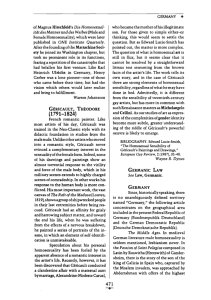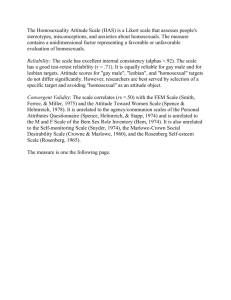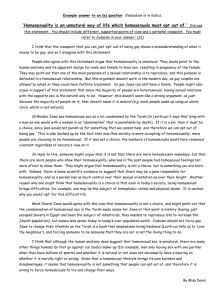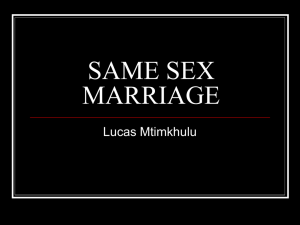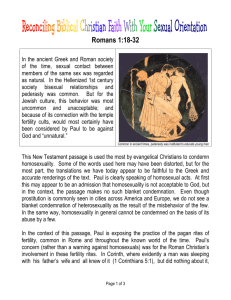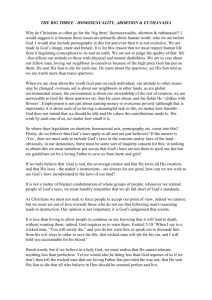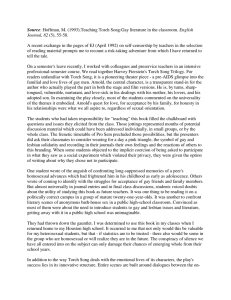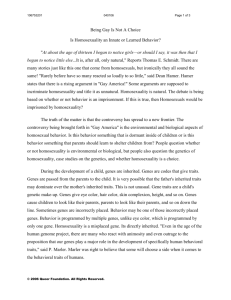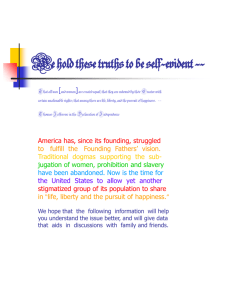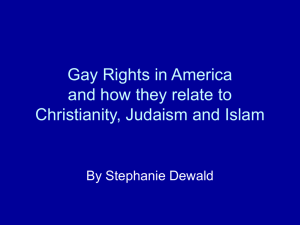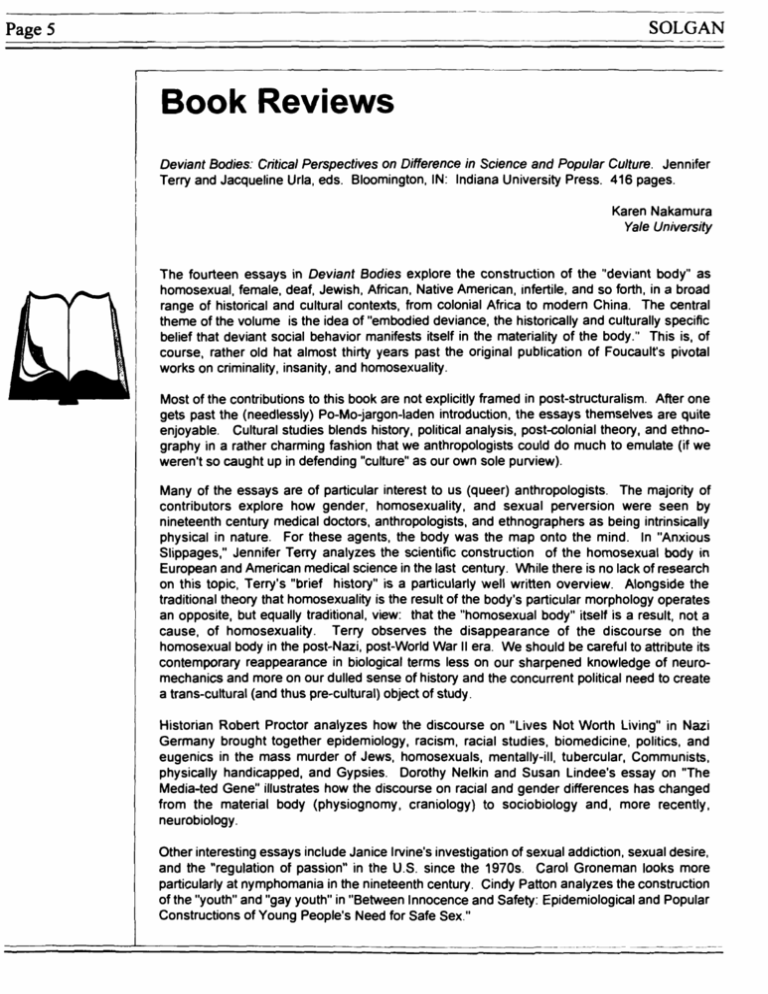
SOLGAN
Book Reviews
Deviant Bodies: Critical Perspectives on Difference in Science and Popular Culture. Jennifer
Terry and Jacqueline Urla, eds. Bloomington, IN: Indiana University Press. 416 pages.
Karen Nakamura
Yale University
The fourteen essays in Deviant Bodies explore the construction of the "deviant body" as
homosexual, female, deaf, Jewish, African, Native American, infertile, and so forth, in a broad
range of historical and cultural contexts, from colonial Africa to modern China. The central
theme of the volume is the idea of "embodied deviance, the historically and culturally specific
belief that deviant social behavior manifests itself in the materiality of the body." This is, of
course, rather old hat almost thirty years past the original publication of Foucault's pivotal
works on criminality, insanity, and homosexuality.
Most of the contributions to this book are not explicitly framed in post-structuralism. After one
gets past the (needlessly) Po-Mo-jargon-laden introduction, the essays themselves are quite
enjoyable. Cultural studies blends history, political analysis, post-colonial theory, and ethnography in a rather charming fashion that we anthropologists could do much to emulate (if we
weren't so caught up in defending "culture" as our own sole purview).
Many of the essays are of particular interest to us (queer) anthropologists. The majority of
contributors explore how gender, homosexuality, and sexual perversion were seen by
nineteenth century medical doctors, anthropologists, and ethnographers as being intrinsically
physical in nature. For these agents, the body was the map onto the mind. In "Anxious
Slippages," Jennifer Terry analyzes the scientific construction of the homosexual body in
European and American medical science in the last century. While there is no lack of research
on this topic, Terry's "brief history" is a particularly well written overview. Alongside the
traditional theory that homosexuality is the result of the body's particular morphology operates
an opposite, but equally traditional, view: that the "homosexual body" itself is a result, not a
cause, of homosexuality. Terry observes the disappearance of the discourse on the
homosexual body in the post-Nazi, post-World War II era. We should be careful to attribute its
contemporary reappearance in biological terms less on our sharpened knowledge of neuromechanics and more on our dulled sense of history and the concurrent political need to create
a trans-cultural (and thus pre-cultural) object of study.
Historian Robert Proctor analyzes how the discourse on "Lives Not Worth Living" in Nazi
Germany brought together epidemiology, racism, racial studies, biomedicine, politics, and
eugenics in the mass murder of Jews, homosexuals, mentally-ill, tubercular, Communists,
physically handicapped, and Gypsies. Dorothy Nelkin and Susan Lindee's essay on "The
Media-ted Gene" illustrates how the discourse on racial and gender differences has changed
from the material body (physiognomy, craniology) to sociobiology and, more recently,
neurobiology.
Other interesting essays include Janice Irvine's investigation of sexual addiction, sexual desire,
and the "regulation of passion" in the U.S. since the 1970s. Carol Groneman looks more
particularly at nymphomania in the nineteenth century. Cindy Patton analyzes the construction
of the "youth" and "gay youth" in "Between Innocence and Safety: Epidemiological and Popular
Constructions of Young People's Need for Safe Sex."
Page 6
SOLGAN
Book Reviews
Post-colonial scholars will enjoy essays on the colonized body by Anne Fausto-Sterling
("Hottentot" women), Nicholas Mirzoeff (the deaf in Arabic harems), Rachel Tolen (the
Salvation Army in India), and K. Tsianina Lomawaima (education in Federal Indian schools).
Susan Jahoda's experimental multimedia montage of photographs, fictitious diary entries,
and texts provides another approach to the female body, while Jacqueline Urla and Alan
Swedlund's "Anthropometry of Barbie" is a humorous exploration of gendered bodies in the
U.S. that will delight and engage your students.
This volume's topical and areal breadth is also its weakness. The papers do not speak to each
other. Each seems to operate in its own particular intellectual vacuum, which is disappointing
since much more could have been accomplished if more effort had been placed into making
the papers work together. "Deviant bodies" as a whole is much too broad as a topical area of
focus. The book might have stood on more solid ground had it restricted itself to just sexuality
or gender (although it might have been be less fun to read).
There are enough relevant articles in this book to justify its use in lesbian and gay studies or
women's studies, especially since many of the chapters summarize and analyze material in a
broad historical frame. It is disappointing that the chapters in the book are as scattered as they
are; but this can be readily fixed by reading selectively.
In closing, the book's greatest contribution to our field is the opportunity it gives us to reflect on
how we construct gender and sexuality in our own work. There is a need for historical
sensitivity and political self-awareness, especially in cross-cultural endeavors, lest we find our
own texts being analyzed and critiqued in similar fashion half a century from now.
American Gay. Stephen O. Murray. World of Desire Series. Chicago: The University of
Chicago Press, 1996. 337pp.
Dennis Altman
La Trobe University
As Stephen Murray attacks large numbers of people in this book, I should perhaps begin this
review by noting that I am not one of them, nor have I ever met Murray. I am, of course,
aware of his work; for the past twenty years Murray has functioned as a free-lance
an thro/sociologist of the gay community, producing a wide range of books and papers, many
of which are the raw materials for American Gay.
While this book is presented as a new work, the great majority of it has appeared previously,
and is not sufficiently reworked to present an overall argument of the sort one expects from a
book. Indeed, over a third of the book comes from one previous work, a Gai Saber
monograph published in 1984. In this, Murray is particularly venomous about what he calls
"the Essex special creationists," especially Jeffrey Weeks, claiming their views were akin to
"neo-closetry." "Special creationism," he writes, "is the ideology provided by intellectuals
eager to deny lesbigay identity at a time when the Christian Right has sought to suppress the
increased visibility of 'alternative lifestyles', homosexuality in particular."

